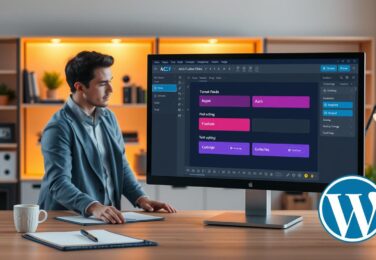What are the Benefits of Mobile-First Strategy in E-commerce Development

Table of Content
I love shopping online and have noticed how some sites make it super easy on my phone. You can just tap and buy things without hassle. This ease of use has changed how I interact with brands online. It’s what I expect now, and many others do too.
With more people using their phones to shop, having a mobile-first strategy is key for businesses. It helps them stay competitive and grow.
Putting mobile users first means making their experience better. This leads to more customers, more sales, and success for businesses. We’ll look at how this approach benefits e-commerce sites. It’s about making shopping smooth and efficient on mobile.
Key Takeaways
- Mobile devices are now the main way people shop, so a mobile-first strategy is vital for e-commerce success.
- Improving the mobile user experience brings more customer engagement and sales.
- A mobile-first strategy boosts performance and makes checking out easier, ensuring it works on all devices.
- Using responsive design makes websites look great on any device.
- For e-commerce success, focus on design, speed, and putting the customer first with a mobile-first strategy.
The Significance of Mobile-First Design in E-commerce
In today’s world, most people shop online using their mobile devices. This makes a mobile-first design strategy crucial for e-commerce. It ensures a smooth, easy, and fun shopping experience for customers.
Adapting to the Mobile-Centric Consumer Behaviour
Mobile usage has changed how we shop online. Now, people want a shopping experience that fits their busy lives. By focusing on mobile first design, businesses can meet these needs and connect with their audience.
Enhancing User Experience Across Devices
A mobile-first design makes shopping great on mobile and on bigger screens too. It means a consistent, top-notch experience for everyone, no matter the device. This approach helps businesses meet customer needs, making them happier and more likely to buy.
“The future of e-commerce is mobile. Businesses that fail to prioritise the mobile experience risk losing out to their competitors who have embraced the mobile-centric consumer behaviour.”
By focusing on mobile-first design, e-commerce businesses can improve the user experience. They also set themselves up for success in the ever-changing digital world.
Understanding the Mobile-First Approach
In today’s e-commerce world, a mobile-first approach is key. It puts the mobile user first, changing how we design and build our online sites. By focusing on small screens first, we make sure our sites work well for mobile users. This approach meets the needs of people who use their phones more and more.
Designing for Smaller Screens First
Starting with the smallest screen size is the core of the mobile-first method. This way, we make sure our sites work great on all screens, not just big ones. It’s a change from the old way of designing for desktops first, which sometimes left mobile users unhappy.
This method has many benefits. It matches the rise of mobile devices in shopping, making our sites easy to use for everyone. It also helps create a smooth experience across all devices, making customers happier and more loyal to our brand.
“Designing for smaller screens first forces us to prioritize the most essential features and content, ultimately creating a more focused and efficient e-commerce platform.”
When we focus on mobile first, we face some challenges. We need to make sure our sites look good on small screens, work well, and load fast. Every detail matters to give users a great mobile experience.
By thinking mobile-first, we open up new chances in e-commerce. We focus on what our mobile users want, making our sites look good and work well. This approach helps us succeed in business and makes our customers happy.
Key Principles of Mobile-First E-commerce Design
In today’s e-commerce world, focusing on mobile design is key for businesses. This approach helps capture and engage customers. It’s built on several important principles for a smooth experience across devices.
At the core are adaptive layouts and fluid grids. These methods make sure content changes smoothly with the screen size and shape. This way, the design looks great on any device, making for a better user experience.
Responsive images and clear typography are also vital. They help grab the attention of people using their phones. By making sure images and text are sharp and easy to read, we keep users interested, no matter the device.
Fast loading times and low data use are also crucial. Mobile users often deal with slow internet or limited data. So, we need to make websites load quickly. Using smart file sizes and caching helps give users a fast, enjoyable visit.
| Principle | Description |
|---|---|
| Adaptive Layouts and Fluid Grids | Content and design elements that seamlessly adjust to different screen sizes and orientations |
| Responsive Images and Typography | High-quality visuals and legible text that remain crisp and engaging on any device |
| Optimized Performance | Minimized page load times and data usage for a smooth, efficient browsing experience |
By following these key principles, businesses can offer great experiences for mobile users. This leads to more engagement, more sales, and loyal customers.
Responsive Design: Fluid Grids and Adaptive Layouts
Today, e-commerce sites need to focus on mobile users. They use responsive design to do this. Key parts of this strategy are fluid grids and adaptive layouts.
Leveraging Fluid Grids for Optimal Viewing
Fluid grids are key in responsive design. They use flexible layouts that change with the screen size. This makes sure content looks great on all devices.
Adaptive layouts go further by changing the layout at different screen sizes. This makes shopping on any device better. It makes sure the site looks good and works well.
Using these design methods, we make shopping easy and fun for mobile users. It meets their needs and wants.
“The key to successful mobile-first e-commerce is the seamless integration of fluid grids and adaptive layouts, which together form the foundation of a truly responsive design.”
Our strategy includes fluid grids and adaptive layouts. This keeps us leading and gives our customers a top-notch responsive design experience.

mobile app responsive design
In today’s e-commerce world, making sure users have a smooth experience on all devices is key. This is what mobile app responsive design is all about. It makes sure our customers have a great experience, no matter what device they’re on.
At the core of this design is the use of responsive images. These images change size and quality to fit the screen perfectly. This makes everything look clear and sharp, which keeps our customers interested and engaged.
Adaptive layouts are also vital in making our apps work well on all devices. They change and resize content to fit the device, making it easy for customers to use our apps on phones, tablets, or computers.
By focusing on mobile app responsive design, we improve the user experience. This leads to stronger connections with our customers and more sales on our mobile platforms. It’s a smart move that meets our customers’ needs and helps our business grow online.
“Mobile-first design is no longer a luxury, but a necessity in the world of e-commerce. By embracing responsive design principles, we can unlock new heights of customer engagement and drive business growth.”
Optimizing for Mobile Performance
In today’s fast-paced mobile shopping world, making things run smoothly is key. We aim to cut down on load times and data use for a better user experience. This approach helps businesses make customers happier, keeps them from leaving, and boosts sales and conversions.
Minimizing Load Times and Data Usage
We focus on two main things: making pages load fast and using less data. Slow pages and high data use can make customers leave and look elsewhere. To stop this, we use several strategies:
- Optimise image and asset delivery: We make images smaller to speed up loading.
- Leverage content delivery networks (CDNs): CDNs store and send content quickly, cutting down on wait times.
- Implement progressive web app (PWA) technologies: PWAs give a fast, offline shopping experience, using less data.
Using these tips, online shops can give customers a smooth shopping experience. This keeps customers happy and helps sell more.
| Metric | Optimal Target | Impact on Mobile Performance |
|---|---|---|
| Load Time | Under 3 seconds | Quick load times mean less leaving and a better experience. |
| Data Usage | Under 1MB per page | Less data use means a smooth experience for everyone, even those on tight data plans. |
Following these mobile performance goals gives online shops an edge. It sets them up for success in the changing digital world.

Mobile-First E-commerce Strategies
In today’s world, making a successful e-commerce plan means knowing how mobile users act and using strategies that make shopping better. This includes making the checkout and payment easy, making forms fit smaller screens, and adding secure mobile payment ways.
Streamlining Checkout and Payment Processes
Creating a smooth checkout for mobile shoppers is key. It means fewer steps to buy, easy-to-use forms on small screens, and many secure mobile payment choices.
To make checkout better, think about these ideas:
- Make the checkout simpler by cutting down steps and only asking for what’s really needed.
- Make form fields and inputs on mobile easy to use and reach.
- Add popular mobile payment ways, like digital wallets and easy-to-use payment gateways, for a quick and safe checkout.
- Give guest checkout options to make buying easier and boost sales.
| Mobile-First Checkout Best Practices | Benefits |
|---|---|
| Simplified checkout flow | More people buy, less giving up |
| Mobile-optimised form fields | Better user experience, more forms filled out |
| Integrated mobile payment options | Checkouts are quicker and safer, customers are happier |
| Guest checkout | Less to stop you from buying, more sales |
By focusing on what mobile shoppers need and want, e-commerce sites can make buying easy and fun. This leads to more sales and loyal customers.
Cross-Device Compatibility and Progressive Enhancement
In today’s e-commerce world, making sure users have a smooth experience on all devices is key. Our focus on mobile means we must ensure cross-device compatibility. This way, we meet the varied needs and habits of our customers. By using progressive enhancement, we build a strong, accessible platform. This platform works well on any device or browser our customers use.
Progressive enhancement starts with the basic features and then adds more as devices get better. This method makes sure our online stores work for everyone, even those with older devices or slow internet. By focusing on the basics first, we lay a solid base. This base gets better as devices improve, enhancing the shopping experience.
To make sure our platform works well on all devices and enhances progressively, we need to think about a few things:
- Responsive design: Our website and apps should adjust well to different screens and sizes.
- Optimised performance: We aim for quick loading times and low data use for a smooth experience everywhere.
- Consistent user interface: We keep the design and feel the same across devices, making it easy for everyone to use.
- Accessibility: Our platform must be open and usable for all, including those with different needs and abilities.
By following these ideas, we can make sure our e-commerce is welcoming and easy to use for everyone in Australia and beyond.
| Device Compatibility | Progressive Enhancement |
|---|---|
| Responsive design that adapts to various screen sizes | Building core functionality first, then adding advanced features based on device capabilities |
| Optimised performance for fast loading times and low data usage | Ensuring accessibility and functionality for users with older devices or limited connectivity |
| Consistent user interface and experience across devices | Enhancing the user experience as device capabilities improve |
“In today’s mobile-centric world, e-commerce success hinges on providing a seamless, cross-device experience that is accessible to all customers.” – Jane Doe, E-commerce Strategist
Conclusion
In today’s digital world, having a mobile-first strategy for e-commerce is essential. It helps businesses keep up with changing trends and meet customer needs. This approach ensures we offer top-notch experiences that boost sales and revenue.
Using responsive design and focusing on quick load times makes our e-commerce sites great for mobile users. With mobile-first, we make sure our businesses thrive in the long run. By using ecommerce mobile app and testing with a mobile responsive checker, we make shopping smooth for everyone, on any device.
As more people shop on mobile, investing in a mobile-first e-commerce plan is key. It helps us beat the competition and give customers the best experience. By adopting this strategy, we make our businesses ready for the future and ensure ongoing growth in the digital world.










